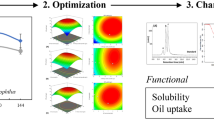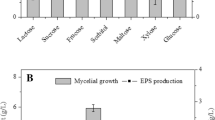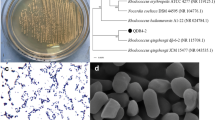Abstract
In the present study, exopolysaccharides (EPS) production by Cupriavidus pauculus 1490 was optimized by response surface methodology. The results showed that sodium gluconate (4.15 g/L), NH4Cl (0.52 g/L), and Na2HPO4·12H2O (0.04 g/L) were the optimal medium components and concentrations. The actual EPS yield of 293.2 m g/L in the optimized medium was in close agreement with the predicted value of 283.35 m g/L. Analysis of fourier transform infrared spectroscopy indicated the EPS contained abundant functional groups, such as –OH, C=O and C–O–C, and all of them were attributed to the characteristics of polysaccharides. Mannose, glucuronic acid, glucose and xylose were detected as the main monosaccharide composition of EPS. Rheological analysis suggested that the rheogram of EPS has similar trend with Xanthan and presented the property of non-Newtonian fluid. Moreover, the addition of NaCl and KCl would partly weaken the shear stress of EPS. Three in vitro assays were conducted to evaluate the antioxidant potential of the EPS. Results demonstrated that the EPS possessed scavenging capacity on hydroxyl radical, DPPH radical and superoxide anion radical in a dose-dependent way. As indicated by above results, the EPS isolated from C. pauculus 1490 might serve as a potential antioxidant agent to be applied in nutraceutical and pharmaceutical industries.






Similar content being viewed by others
Data Availability
The raw/processed data required to reproduce these findings cannot be shared at this time as the data also forms part of an ongoing study.
Code Availability
Not applicable.
References
Ye S, Feng L, Wang J, Wang H, Zhang M (2012) Antioxidant activities of an exopolysaccharide isolated and purified from marine Pseudomonas PF-6. Carbohydr Polym 87(1):764–770
Hussain A, Zia KM, Tabasum S, Noreen A, Zuber M (2017) Blends and composites of exopolysaccharides; properties and applications: a review. Int J Biol Macromol 94(Pt A):10–27
Xu L, Dong M, Gong H, Sun M, Li Y (2015) Effects of inorganic cations on the rheology of aqueous welan, xanthan, gellan solutions and their mixtures. Carbohydr Polym 121:147–154
Moretto C, Castellane TCL, Lopes EM, Omori WP, Sacco LP, Lemos EGM (2015) Chemical and rheological properties of exopolysaccharides produced by four isolates of rhizobia. Int J Biol Macromol 81:291–298
Castellane T, Campanharo JC, Colnago LA, Coutinho ID, Lopes ÉM, Lemos M, Lemos E (2017) Characterization of new exopolysaccharide production by Rhizobium tropici during growth on hydrocarbon substrate. Int J Biol Macromol 96:361–369
Xu CL, Wang YZ, Jin ML, Yang XQ (2009) Preparation, characterization and immunomodulatory activity of selenium-enriched exopolysaccharide produced by bacterium Enterobacter cloacae Z0206. Bioreour Technol 100(6):2095–2097
Freitas F, Alves VD, Reis M (2011) Advances in bacterial exopolysaccharides: from production to biotechnological applications. Trends Biotechnol 29(8):388–398
Shi Z, Gao X, Ullah MW, Li S, Wang Q, Yang G (2016) Electroconductive natural polymer-based hydrogels. Biomaterials 111:40–54
Meng Z, Cui N, Qu F, Xue H, Fang Y (2017) Novel nano-particulated exopolysaccharide produced by Klebsiella sp. PHRC1.001. Carbohydr Polym 171:252
Vandamme P, Coenye T (2004) Taxonomy of the genus Cupriavidus: a tale of lost and found. Int J Syst Evol Microbiol 54:2285–2289
Kutralam-Muniasamy G, Perez-Guevara F (2019) Comparative genome analysis of completely sequenced Cupriavidus genomes provides insights into the biosynthetic potential and versatile applications of Cupriavidus alkaliphilus ASC-732. Can J Microbiol 65(8):575–595
Ribeiro PLL, Campos MI, Druzian JI (2017) Novel extracellular polymeric substances produced by Cupriavidus necator IPT 027 grown on glucose and crude glycerol originated from biodiesel. Polym Adv Technol 28(4):549–556
Arundhati P, Paul AK (2013) Optimization of cultural conditions for production of extracellular polymeric substances (EPS) by serpentine rhizobacterium Cupriavidus pauculus KPS 201. J Ploym. https://doi.org/10.1155/2013/692374
Li XL, Zhou AG, Han Y (2006) Anti-oxidation and anti-microorganism activities of purification polysaccharide from Lygodium japonicum in vitro. Carbohydr Polym 66(1):34–42
Chen Y-Y, Xue Y-T (2019) Optimization of microwave assisted extraction, chemical characterization and antitumor activities of polysaccharides from porphyra haitanensis. Carbohydr Polym 206:179–186
Ghiselli A, Nardini M, Baldi A, Scaccini C (1998) Antioxidant activity of different phenolic fractions separated from an italian red wine. J Agric Food Chem 46(2):361–367
Wang J, Ji Z, Zhao B, Wang X, Wu Y, Jian Y (2010) A comparison study on microwave-assisted extraction of Potentilla anserina L. polysaccharides with conventional method: molecule weight and antioxidant activities evaluation. Carbohydr Polym 80(1):84–93
Yan C, Hu M, Cui W, Yang Y, Chen J, Ding J, Guo W (2013) Characterization and in vitro antitumor activity of polysaccharides from the mycelium of Sarcodon aspratus. Int J Biol Macromol 52:52–58
Jiang YY, Wang L, Zhang L, Wang T, Yu L, Ding CB, Yang RW, Wang XL, Zhou YH (2014) Characterization, antioxidant and antitumor activities of polysaccharides from Salvia miltiorrhiza Bunge. Int J Biol Macromol 70:92–99
Mei Y, Zhu H, Hu Q, Liu Y, Zhao S, Peng N, Liang Y (2015) A novel polysaccharide from mycelia of cultured Phellinus linteus displays antitumor activity through apoptosis. Carbohydr Polym 124:90–97
Jia X, Dong L, Yang Y, Yuan S, Zhang Z, Yuan M (2013) Preliminary structural characterization and antioxidant activities of polysaccharides extracted from Hawk tea (Litsea coreana var. lanuginosa). Carbohydr Polym 95(1):195–199
Chen R, Liu Z, Zhao J, Chen R, Meng F, Zhang M, Ge W (2011) Antioxidant and immunobiological activity of water-soluble polysaccharide fractions purified from Acanthopanax senticosu. Food Chem 127(2):434–440
Lei X, Yan L, Yunzhe C, Pengying Z (2019) Polysaccharide produced by Bacillus subtilis using burdock oligofructose as carbon source. Carbohydr Polym 206:811–819
Zhang J, Wen C, Gu J, Ji C, Duan Y, Zhang H (2019) Effects of subcritical water extraction microenvironment on the structure and biological activities of polysaccharides from Lentinus edodes. Int J Biol Macromol 123:1002–1011
Zhao T, Mao G, Feng W, Mao R, Wu X (2014) Isolation, characterization and antioxidant activity of polysaccharide from Schisandra sphenanthera. Carbohydr Polym 105(1):26–33
Yan L, Lei X, Yunzhe C, Ge S, Jun H (2018) Structural characteristics and anticancer/antioxidant activities of a novel polysaccharide from Trichoderma kanganensis. Carbohydr Polym 205:63–71
Tang J, Qi S, Li Z, An Q, Xie M, Yang B, Wang Y (2014) Production, purification and application of polysaccharide-based bioflocculant by Paenibacillus mucilaginosus. Carbohydr Polym 113:463–470
Raza W, Makeen K, Wang Y, Xu Y, Shen Q (2011) Optimization, purification, characterization and antioxidant activity of an extracellular polysaccharide produced by Paenibacillus polymyxa SQR-21. Bioresour Technol 102(10):6095–6103
Giulia F, Shauvik D, Vrouwenvelder J, Padding JT, Buist KA, Alfred J, Fredrik I, Kuipers J (2018) Experimental investigation of non-Newtonian droplet collisions: the role of extensional viscosity. Exp Fluids 59(7):1–16
Shojaeian M, Karimzadehkhouei M, Koşar A (2017) Experimental investigation on convective heat transfer of non-newtonian flows of xanthan gum solutions in microtubes. Exp Therm Fluid Sci 85:305–312
Diaz PS, Vendruscolo CT, Vendruscolo JLS (2004) Xanthan Rheological: a review about the influence of electrolytes on the viscosity of aqueous solutions of xanthan gums. Semina Ciências Exatas e Tecnológicas 25(1):15
Aruoma OI (1998) Free radicals, oxidative stress, and antioxidants in human health and disease. J Am Oil Chem Soc 75(2):199–212
Kang Q, Chen S, Li S, Wang B, Liu X, Hao L, Lu J (2019) Comparison on characterization and antioxidant activity of polysaccharides from Ganoderma lucidum by ultrasound and conventional extraction. Int J Biol Macromol 124:1137–1144
Fooladi T, Soudi MR, Alimadadi N, Savedoroudi P, Heravi MM (2019) Bioactive exopolysaccharide from Neopestalotiopsis sp. strain SKE15: production, characterization and optimization. Int J Biol Macromol 129:127–139
Maira S-C, Ruiz-Ruiz J, Chel-Guerrero L, Betancur-Ancona D (2013) Antioxidant activity of Vigna unguiculata L. walp and hard-to-cook Phaseolus vulgaris L. protein hydrolysates. CyTA J Food 11(3):208–215
Lo CT, Cheng AC, Chiu KH, Tsay PK, Jen JF (2011) Correlation evaluation of antioxidant properties on the monosaccharide components and glycosyl linkages of polysaccharide with different measuring methods. Carbohydr Polym 86(1):320–327
Banerjee A, Dasgupta N, De B (2005) In vitro study of antioxidant activity of Syzygium cumini fruit. Food Chem 90(4):727–733
Pang X, Wang PG, Min C (2019) Isolation and characterization of an antioxidant exopolysaccharide produced by Bacillus sp. S-1 from Sichuan Pickles. Carbohydr Polym 204:9–16
Li J, Chi Z, Yu L, Jiang F, Liu C (2017) Sulfated modification, characterization, and antioxidant and moisture absorption/retention activities of a soluble neutral polysaccharide from Enteromorpha prolifera. Int J Biol Macromol 105:1544–1553
Acknowledgements
This work was supported by the National Natural Science Foundation of China (Nos. 51934009 and 52074353), National Key Research and Development Program of China (No. 2019YFC1803600).
Author information
Authors and Affiliations
Contributions
MCX, SSZ: conceptualization, experimental investigation, writing, reviewing, and editing; LS, RLY, YDL, JKL, XLW, MC, WMZ: reviewing and editing; LS, GZQ, WMZ: funding acquisition.
Corresponding author
Ethics declarations
Conflict of interest
The authors declare that they have no conflict of interest.
Ethical Approval
All authors approved.
Consent to Participate
All authors approved.
Consent for Publication
All authors approved.
Additional information
Publisher's Note
Springer Nature remains neutral with regard to jurisdictional claims in published maps and institutional affiliations.
Rights and permissions
About this article
Cite this article
Xia, M., Zhang, S., Shen, L. et al. Optimization and Characterization of an Antioxidant Exopolysaccharide Produced by Cupriavidus pauculus 1490. J Polym Environ 30, 2077–2086 (2022). https://doi.org/10.1007/s10924-021-02339-4
Accepted:
Published:
Issue Date:
DOI: https://doi.org/10.1007/s10924-021-02339-4




